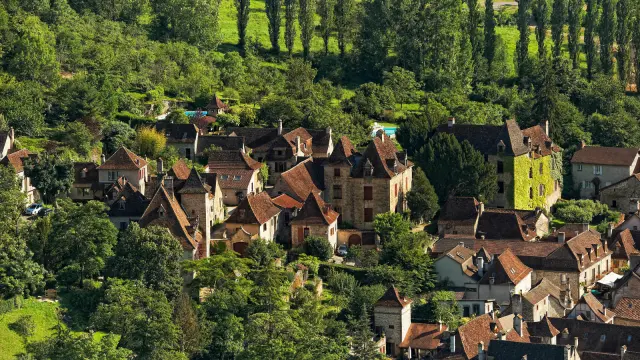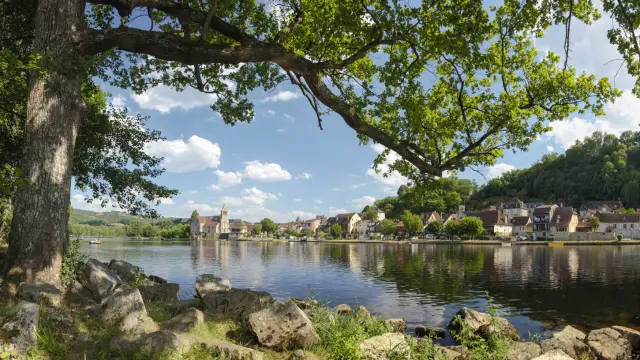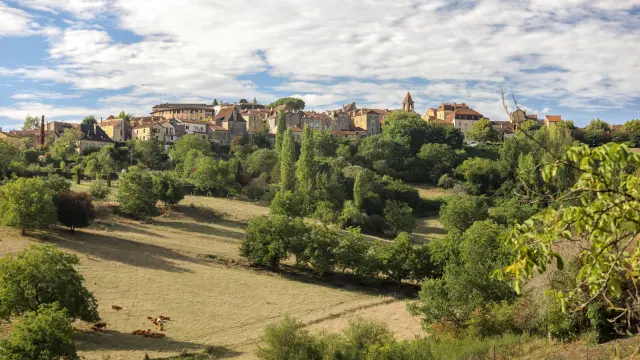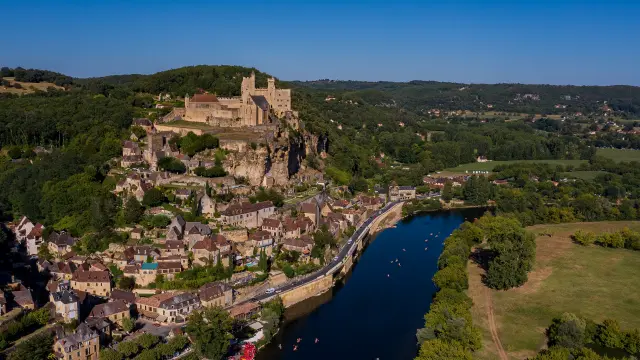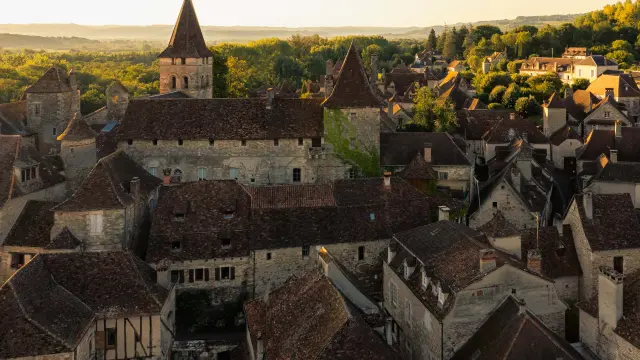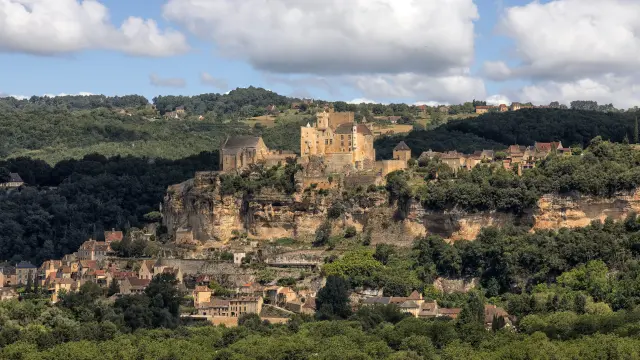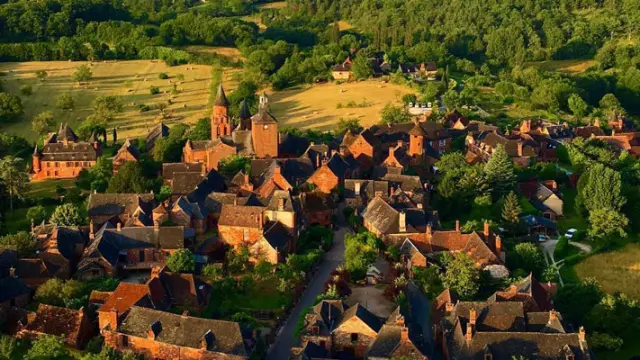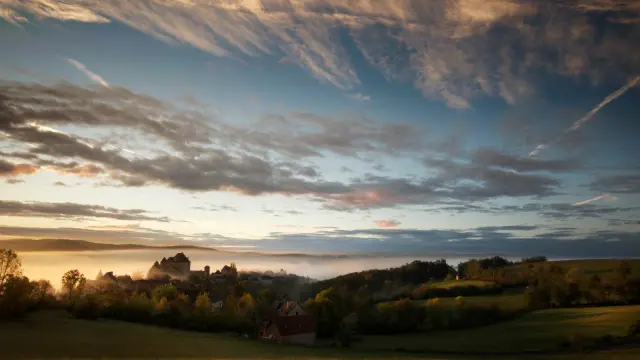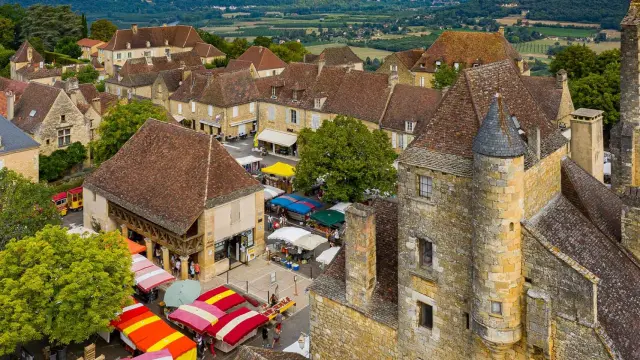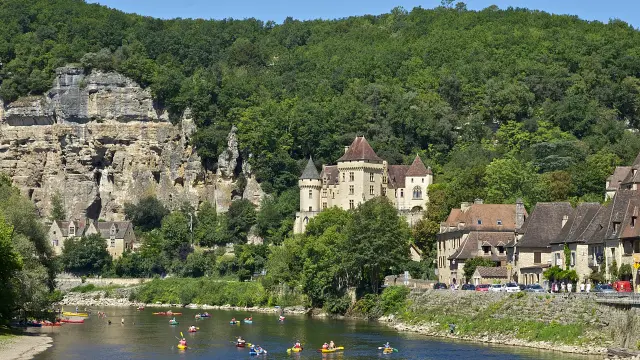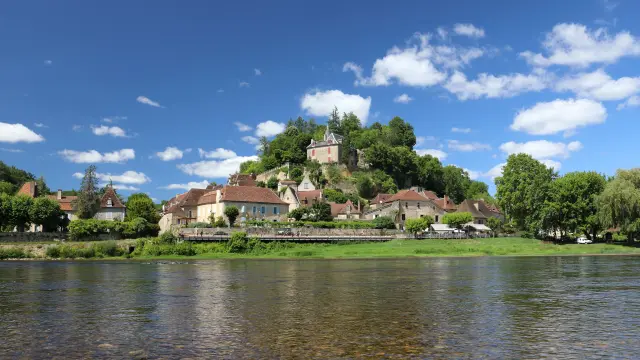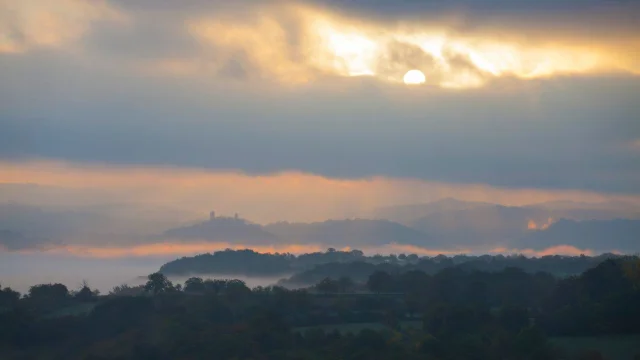Just southwest of Padirac in the Causses du Quercy Regional Nature Park stands the sacred village of Rocamadour. Built on 3 successive levels, Rocamadour is both a place of legend and history where old stone houses, majestic towers and a castle keep cascade off the cliff into the Alzou Canyon.
 Bougies.jpg
Bougies.jpgRocamadour
The Sacred CityA great pilgrimage site
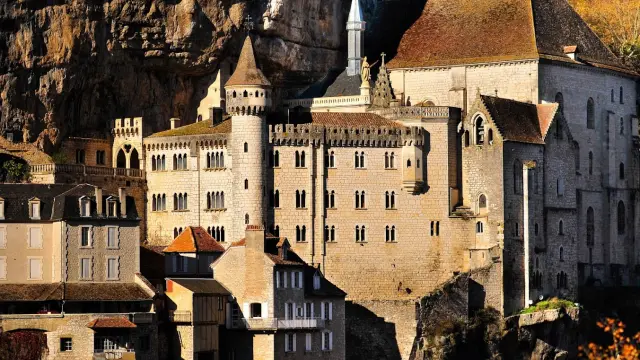
Not only is the village one of France’s most important tourist destinations and a UNESCO World Heritage Site, it has also been a crucial pilgrimage site on the ‘Way of Saint James’ for hundreds of years.
Rising up 120 metres, this vertiginous Citadel of Faith is best summed up by an old local saying: ‘Houses on the river, churches on the houses, rocks on the churches, castle on the rock’.
The sacred city of Rocamadour boasts 4 beautiful arched stone gates: Porte Basse, Porte du Figuier, Porte Salmon and Porte Hugon.
The town below the monastic buildings lies on the lowest slopes. Trimmed with beautiful gold stone houses and lauzé roofs, the main street is entirely car-free and houses a number of charming restaurants and quirky boutiques.
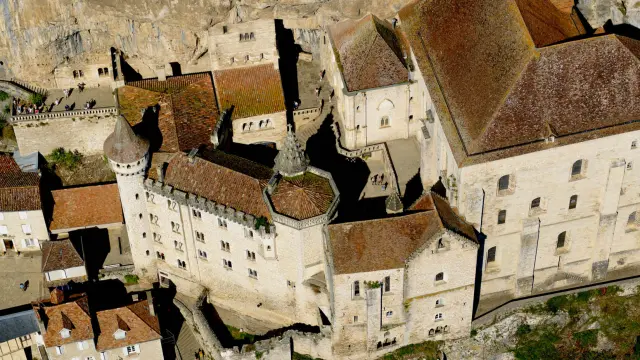 Le Sanctuaire De Rocamadour Vue D Avion.jpg
Le Sanctuaire De Rocamadour Vue D Avion.jpg Rocamadour Sur Son Rocher 2.jpg
Rocamadour Sur Son Rocher 2.jpgA thousand years of History
In 1166, an incorruptible body was found buried where the Sanctuary now lays. This discovery propelled Rocamadour to become one of the 4 most important pilgrimage sites in medieval Christiandom, attracting Kings and paupers alike.
The 216 steps that make up the Great Staircase separate the lower town from the complex of religious structures that are set halfway up the cliff. The Sanctuary made of 8 chapels is built around a central courtyard.
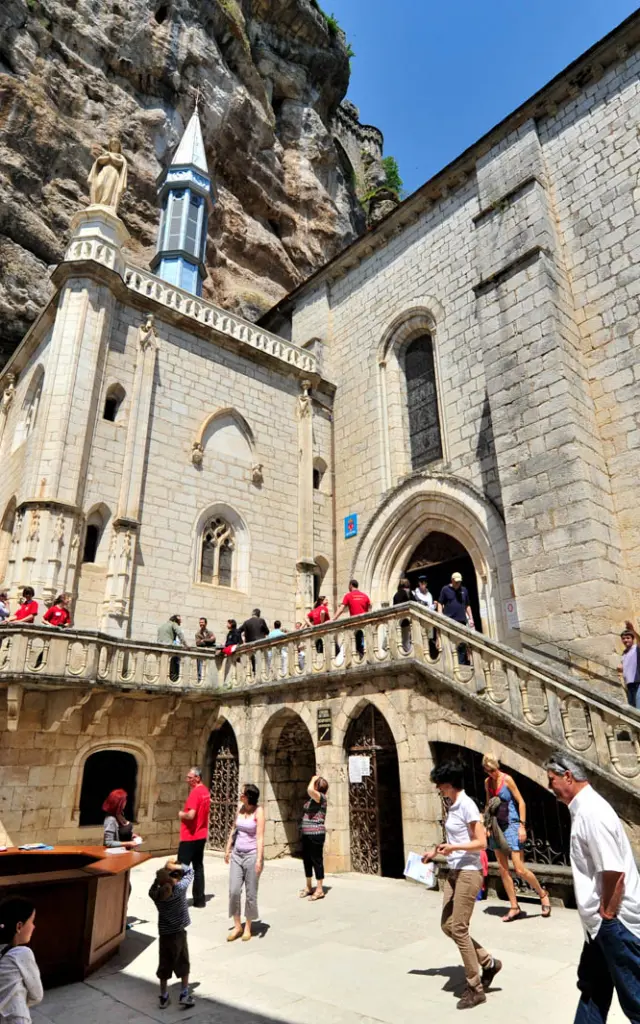 1504173416 176449756.jpg
1504173416 176449756.jpg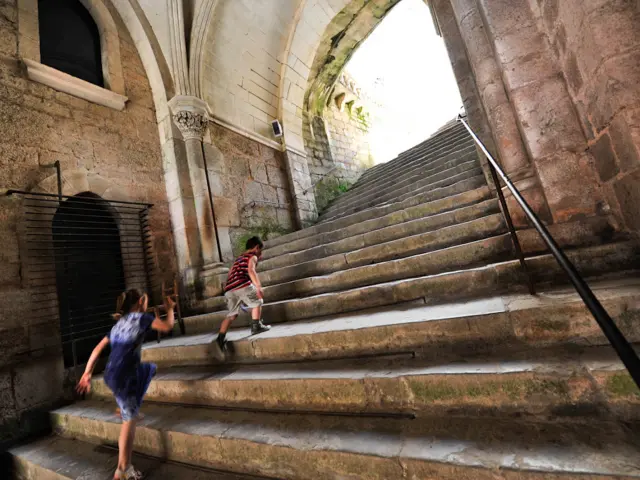 Grand Escalier A Rocamadour C Cochise 3.jpg
Grand Escalier A Rocamadour C Cochise 3.jpg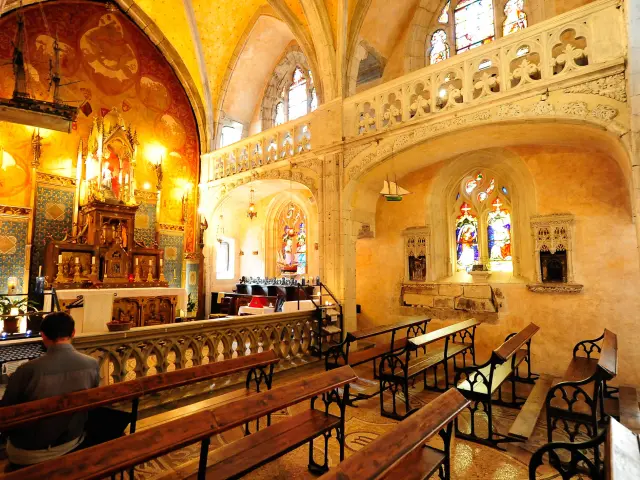 Chapelle De La Vierge Noire A Rocamadour 0.jpg
Chapelle De La Vierge Noire A Rocamadour 0.jpg Rocamadour C 800.jpg
Rocamadour C 800.jpg Visite Guidee Rocamadour Le Grand Escalier Bobd.jpg
Visite Guidee Rocamadour Le Grand Escalier Bobd.jpg Rocamadour Nuit 1.jpg
Rocamadour Nuit 1.jpgThe Chapelle Notre Dame and the Vierge Noire statue are the highlight of any visitor’s trip. Carved from the wood of a walnut tree in the 12th century, the Black Madonna has ever since drawn worshippers from all over Europe in search of miracles.
Overhead, the 9th-century iron bell is said to ring on its own when somewhere in the world the Virgin performes a miracle. Many recorded miracles are linked to sailors in peril at sea, hence the boats hanging from the ceiling.
Backed against the cliffs next to the chapel lies the UNESCO-listed Basilique Saint-Sauveur, built in the Romanesque-Gothic style. The medieval city is also home to the crypt of Saint-Amadour, just below the basilica.
As an act of penance in previous times, pilgrims would do the 216-step climb to the Sanctuary on their knees. However, today’s visitors mostly concentrate on getting to the top without losing their breath (big pat on the back for those who do…) No need to fear though, 2 lifts linking the lower town to the castle are available for the less sporty vacationers.
Sightseeing in Rocamadour
Rocamadour’s stunning castle was built to defend the village’s Sanctuary in the Middle Ages and sits proudly at the top of the village in an extraordinary balancing act.
Only the castle’s ramparts are open to visitors but the viewpoints over the Alzou Valley are simply breathtaking. Remember to keep an eye out for the birds flying to and from the ‘Rocher des Aigles’ falconry display nearby.
Visitors that have still got energy to burn and who are looking for a glimpse of the village as a whole should take the shady path towards L’Hospitalet. Inhabitated as early as the Upper Palaeolithic era, this hamlet offres a picture-postcard view of the golden stone village cascading into the canyon.
Nearby, the prehistoric Grotte des Merveilles boasts an underground world of stalactites, lakes and original Paleolithic drawings of horses and deer that date back to 20,000 B.C. The pre-historic artists created the paintings by airbrushing red and black pigment onto the rocks using animal bones and a variety of different stencils like hands. The cave is easily accessible with only a short walk down some steps.
The monkey park “La Forêt des Singes” is also a must while visiting Rocamadour, particularly with children. A chance to get up close and personal with 150 barbary macaques roaming free in a large shady park.
Keep in mind that the village continues to be an active place of worship so it’s advised to dress accordingly. With a million visitors flocking to Rocamadour every year, try and plan a visit to the sacred marvel early in the morning as it can often get quite busy during the day.
 Admirer les vautours du #RocherDesAigles #zoo #Rocamadour 🦅🐣
Admirer les vautours du #RocherDesAigles #zoo #Rocamadour 🦅🐣 1503065556 956322704.jpg
1503065556 956322704.jpgEvents in Rocamadour
Cheese Festival
A speciality in Rocamadour and the Quercy Limestone plateaus, Rocamadour cheese or ‘Cabécou’ is made with unpasteurized goat’s milk and has been designated the AOC quality label.
Presented in the shape of a small disk, Rocamadour cheese can either be eaten warm on a slice of walnut bread or in a salad and will undoubtedly tickle any cheese lover’s tastebuds.
In June, the Rocamadour AOC cheese festival is celebrated on Pentecost Sunday with a large market, cheese tasting, live music and activities for the kiddies.
 Rocamadour AOP - La Borie d'Imbert
Rocamadour AOP - La Borie d'ImbertHot-air balloon Festival
Every last weekend of September, the annual Hot Air Balloon Festival “Les Montgolfiades” sees 30-odd participants from all over Europe taking to skies from the foot of the Sacred City.
Remember to make an early start as over 20,000 spectators come to enjoy the show each year. Visitors can choose to watch from various slopes in the surrounding valley.
There’s also a fantastic firework display as well as a great brocante for those looking to take home a French antique and spruce it up a little.
 Les montgolfières à Rocamadour
Les montgolfières à RocamadourSummer pasture
Another of Rocamadour’s events takes place in spring when hundreds of sheep migrate from Rocamadour to the uplands for the annual Transhumance. Visitors and locals are welcome to join the flock for a five day walk along the Dordogne’s idyllic country lanes and paths guided by local shepherds that know the region like the backs of their hands.
 Pnr Causses Du Quercy Moutons Sur Le Causse.jpg
Pnr Causses Du Quercy Moutons Sur Le Causse.jpg